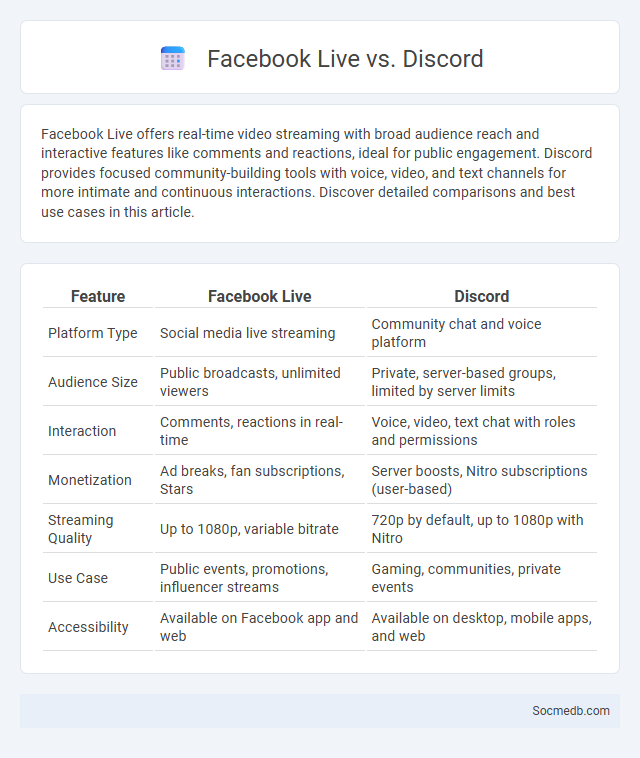
Photo illustration: Facebook Live vs Discord
Facebook Live offers real-time video streaming with broad audience reach and interactive features like comments and reactions, ideal for public engagement. Discord provides focused community-building tools with voice, video, and text channels for more intimate and continuous interactions. Discover detailed comparisons and best use cases in this article.
Table of Comparison
| Feature | Facebook Live | Discord |
|---|---|---|
| Platform Type | Social media live streaming | Community chat and voice platform |
| Audience Size | Public broadcasts, unlimited viewers | Private, server-based groups, limited by server limits |
| Interaction | Comments, reactions in real-time | Voice, video, text chat with roles and permissions |
| Monetization | Ad breaks, fan subscriptions, Stars | Server boosts, Nitro subscriptions (user-based) |
| Streaming Quality | Up to 1080p, variable bitrate | 720p by default, up to 1080p with Nitro |
| Use Case | Public events, promotions, influencer streams | Gaming, communities, private events |
| Accessibility | Available on Facebook app and web | Available on desktop, mobile apps, and web |
Introduction to Live Streaming Platforms
Live streaming platforms enable real-time video broadcasting to audiences across the globe, transforming social media engagement with interactive content. Popular platforms like Twitch, YouTube Live, and Facebook Live offer unique tools for creators to connect instantly with viewers, fostering community building and brand promotion. The surge in live streaming usage highlights a shift toward dynamic, authentic content consumption that drives higher user engagement and monetization opportunities.
Overview: Facebook Live, Discord, and Other Streaming Options
Facebook Live offers real-time video broadcasting that enables you to engage directly with your audience through comments and reactions, enhancing interaction and reach on the platform. Discord supports streaming within servers, allowing communities to watch and participate in live content seamlessly while maintaining close-knit communication through voice and text channels. Other streaming options such as Twitch and YouTube Live provide specialized tools for gaming, tutorials, and events, giving your content a broader platform to connect with diverse audiences.
User Interface and Ease of Use Comparison
Social media platforms like Facebook, Instagram, and Twitter offer distinct user interfaces tailored to their core functions, with Instagram emphasizing visual content through a clean, image-focused layout, while Twitter prioritizes text and real-time updates with a streamlined tweet-centric design. Ease of use varies, as Facebook's comprehensive features may present a steeper learning curve compared to Snapchat's intuitive, gesture-based navigation optimized for rapid content sharing. User interface simplicity aligns closely with user engagement metrics, where platforms offering straightforward, accessible controls tend to retain users longer and encourage more frequent interaction.
Audience Reach and Community Engagement
Social media platforms amplify audience reach by leveraging targeted algorithms that connect brands with users most likely to engage with their content, increasing visibility and conversion rates. High community engagement is achieved through interactive features such as comments, shares, and live sessions, fostering loyalty and real-time communication. Businesses utilizing analytics tools can measure audience behavior to refine strategies, boosting both reach and engagement effectively.
Streaming Quality and Performance
Streaming quality and performance on social media platforms significantly impact user engagement and satisfaction. High-definition video, low buffering times, and adaptive bitrate streaming ensure your content reaches audiences smoothly across varying internet speeds. Optimizing these factors enhances viewer retention and elevates your brand's digital presence.
Monetization and Revenue Opportunities
Social media platforms offer diverse monetization and revenue opportunities such as sponsored content, affiliate marketing, and paid subscriptions. Your ability to leverage audience engagement through targeted advertisements and brand partnerships can significantly boost income streams. Understanding platform-specific tools like Facebook Ads Manager or Instagram Shopping is essential for maximizing financial returns.
Privacy, Security, and Content Moderation
Social media platforms implement robust privacy settings to protect your personal data from unauthorized access and ensure secure communication. Advanced security measures like encryption and two-factor authentication guard against cyber threats and hacking attempts. Content moderation employs AI algorithms and human review teams to maintain community standards and prevent harmful or inappropriate content from spreading.
Integration with Other Platforms and Tools
Social media platforms offer robust integration capabilities with a variety of third-party tools such as customer relationship management (CRM) systems, email marketing software, and analytics platforms to streamline your marketing efforts. APIs and native integrations enable seamless data synchronization, allowing you to monitor engagement metrics, schedule posts, and automate workflows across multiple channels. Leveraging these integrations maximizes efficiency and provides comprehensive insights into your social media performance.
Use Cases: Gaming, Events, and Business Applications
Social media platforms enhance gaming experiences by enabling live streaming, community building, and real-time interaction, boosting player engagement and game visibility. Event organizers leverage social media for targeted promotions, live updates, and audience interaction, increasing attendance and brand presence. Businesses utilize social media for customer support, market research, influencer partnerships, and lead generation, driving sales growth and brand loyalty.
Conclusion: Choosing the Best Live Streaming Platform
Selecting the best live streaming platform depends on your specific goals, audience engagement features, and content type compatibility. Analyze platform metrics such as viewer reach, interactive tools, and monetization options to maximize your streaming success. Your ideal choice should balance technical reliability with user-friendly interfaces to enhance both content delivery and viewer experience.
 socmedb.com
socmedb.com